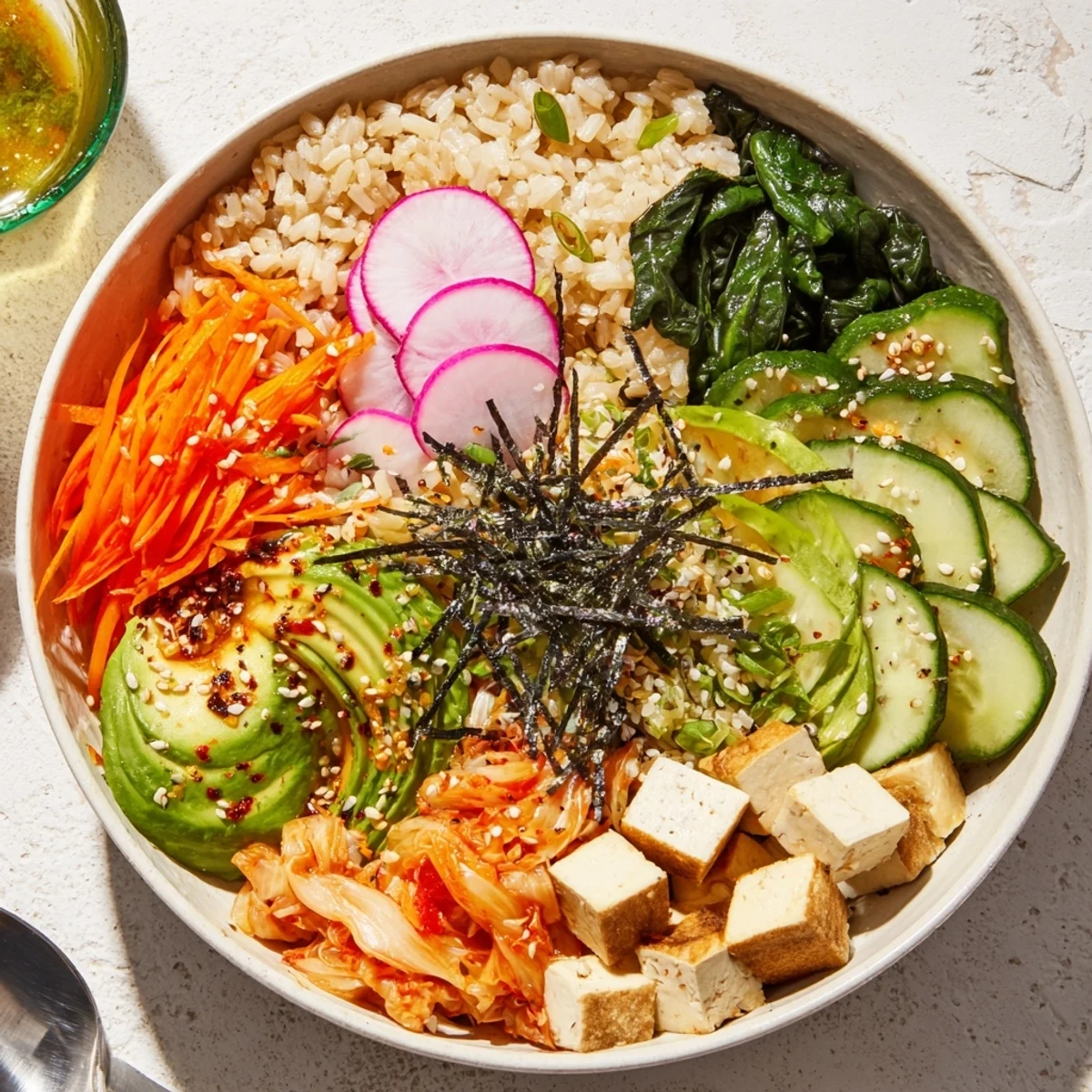 Save
Save A vibrant, nourishing bowl featuring tangy kimchi, fresh seasonal vegetables, hearty grains, and a flavorful dressing—perfect for a wholesome lunch or dinner.
I created this bowl during a busy week when I craved something fresh and filling. The satisfying mix of warm grains and crunchy vegetables lifted my spirits, and the tangy kimchi made it a recipe I return to again and again.
Ingredients
- Grains: 1 cup (180 g) brown rice or quinoa, uncooked; 2 cups (480 ml) water; 1/2 tsp salt
- Fermented Vegetables: 1 cup (150 g) kimchi, chopped (ensure vegetarian if needed); 1/2 cup (75 g) sauerkraut (optional, for variety)
- Fresh Vegetables: 1 cup (100 g) shredded carrots; 1 cup (80 g) cucumber, sliced; 1 cup (60 g) baby spinach or mixed greens; 1 avocado, sliced; 2 radishes, thinly sliced; 1/4 cup (15 g) scallions, sliced
- Protein (optional, for added nutrition): 1 cup (160 g) cooked edamame or firm tofu, cubed
- Dressing: 2 tbsp soy sauce or tamari; 1 tbsp toasted sesame oil; 1 tbsp rice vinegar; 1 tsp maple syrup or honey; 1 tsp grated fresh ginger; 1 small garlic clove, minced
- Toppings: 1 tbsp toasted sesame seeds; 1 sheet nori, sliced (optional); Chili flakes (optional)
Instructions
- Cook the Grains:
- Rinse the grains and cook them with water and salt according to package instructions (about 25 minutes for brown rice, 15 minutes for quinoa). Once cooked, fluff with a fork and let cool slightly.
- Prep Vegetables:
- Prepare all fresh vegetables: shred carrots, slice cucumber, avocado, radishes, and scallions.
- Prepare Protein (if using):
- If using tofu, pat dry and cube. Optionally, pan-sear the tofu in a nonstick pan over medium heat with a splash of oil until golden on all sides.
- Make the Dressing:
- In a small bowl, whisk together the soy sauce, sesame oil, rice vinegar, maple syrup, ginger, and garlic to make the dressing.
- Assemble the Bowls:
- To assemble, divide the cooked grains among four bowls. Arrange kimchi, sauerkraut (if using), fresh vegetables, and protein on top of the grains.
- Finish and Serve:
- Drizzle each bowl with the dressing. Garnish with sesame seeds, nori, and chili flakes if desired. Serve immediately and enjoy.
 Save
Save This bowl has become a weekend favorite in our home. My kids love choosing their vegetables and toppings, making each meal unique and colorful.
Required Tools
Medium saucepan (for grains), mixing bowls, chefs knife, cutting board, whisk
Allergen Information
Contains soy (soy sauce, tofu, edamame, kimchi may contain soy), sesame (toasted sesame oil, sesame seeds). Kimchi may contain fish sauce or shellfish; check labels for vegetarian or vegan options. If using tamari, choose gluten-free for those with gluten sensitivity. Always double-check ingredient labels if you have allergies.
Nutritional Information (per serving)
Calories: 350, Total Fat: 10 g, Carbohydrates: 54 g, Protein: 11 g
 Save
Save Serve this bowl right away for the freshest flavors. Feel free to mix and match ingredients to create your signature version.
Recipe FAQs
- → What grains can I use in the bowl?
Brown rice and quinoa work well, but farro, barley, or cauliflower rice add variety to the base.
- → How can I make this dish vegan?
Use maple syrup in the dressing and confirm your kimchi does not contain fish sauce or seafood, ensuring it is fully plant-based.
- → Is there a gluten-free option?
Use quinoa or certified gluten-free grains, and swap soy sauce for gluten-free tamari to avoid gluten.
- → What proteins are suitable for this bowl?
Try tofu, edamame, grilled chicken, or a soft-boiled egg for varied protein options. Choose according to dietary preferences.
- → Can I prep the bowl ingredients ahead?
Yes, you can cook grains and chop vegetables in advance. Keep components separate and assemble when ready to eat.
- → What can I add for extra crunch or flavor?
Include microgreens, sliced radishes, or a sprinkle of chili flakes for added freshness and zing.